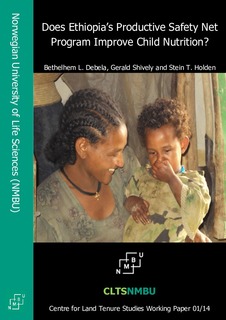Bushmeat harvest in tropical forests: Knowledge base, gaps and research priorities
Effects of soil erosion on sediment dynamics, food security and rural poverty in Makueni District
Makueni District has experienced low crop production per unit area despite increased hectarage under crop
production. The district relies heavily on farming for food and income generating activities for the households.
However, poverty level has been on the increase due to poor crop production and limited diversity in sources of
income. Analysis of field survey carried in the district shows high variability of soil nutrients (Nitrogen,
Phosphorous, and potassium), Cation Exchange Capacity (CEC) and soil pH due to various land use systems
Does Ethiopia's productive safety net program improve child nutrition?
We study the link between Ethiopia’s Productive Safety Net Program (PSNP) and short-run nutrition outcomes among children age 5 years and younger. We use 2006 and 2010 survey data from Northern Ethiopia to estimate parameters of an exogenous switching regression. This allows us to measure the differential impacts of household characteristics on weight-for-height Z-score of children in member and non-member households in PSNP. We find that the magnitude and significance of household covariates differ in samples of children from PSNP and non-PSNP households.
Gender dynamics in mango production system in India
Rural women in India are rarely consulted in development projects that may increase men’s production and income, but add to their own workloads. Women’s on-farm household and productive labor is significant but underrecognized and under-valued. Women farmers have no rights to farmlands, though most farm production is carried out by them. This paper addresses women’s decision making regarding mango production.
Werken aan bodemweerbaarheid Voortgang 2013
De land- en tuinbouw ontwikkelt zich in de richting van steeds intensievere en complexere bedrijfssystemen. Vanuit de sector groeit het besef dat de chemische benadering van ziekten en plagen haar grenzen begint te bereiken. Ook de consument verlangt van de producent dat de inzet van chemische middelen gereduceerd wordt en gezocht wordt naar andere, meer duurzame oplossingen. Een van de oplossingsrichtingen is het creëren van een gezonde, veerkrachtige en weerbare bodem.
Let the numbers speak : Comparing Better Cotton Fast Track Program participants and non-participants in India, Mali, and Pakistan using agronomic data of the Better Cotton Initiative
Terra Incognita:Land degradation as underestimated threat amplifier. Clingendael Report
Land degradation is increasingly recognised as global challenge and is even pushed for as candidate for a (post-2015) Sustainable Development Goal (SDG). The ‘quality of soil’ has been linked to the emergence of conflict, inter alia since it aggravates food and water scarcity. It is an underestimated, but essential element in the nexus of global challenges related to food, water and energy. This Clingendael Report, finds, amongst others, that accurate assessments on land degradation and efforts to restore lands are still lacking to date.
Down on the farm: Wall street: America's new farmer
The first years of the twenty-first century will be remembered for a global land rush of nearly unprecedented scale. An estimated 500 million acres, an area eight times the size of Britain, was reported bought or leased across the developing world between 2000 and 2011, often at the expense of local food security and land rights. When the price of food spiked in 2008, pushing the number of hungry people in the world to over one billion, the interest of investors spiked as well, and within a year foreign land deals in the developing
Assessing global land use: Balancing consumption with sustainable supply
This report explores how the management of land-based biomass production and consumption can be developed towards a higher degree of sustainability across different scales: from the sustainable management of soils on the field to the sustainable management of global land use as a whole. Under business as usual conditions, the growing demand for food and non-food biomass could lead to a gross expansion of cropland in the range of 320 to 850 million hectares by 2050.
Desertification: The invisible frontline
Desertification is a silent, invisible crisis that is destabilizing communities on a global scale. As the effects of climate change undermine livelihoods, inter-ethnic clashes are breaking out within and across states and fragile states are turning to militarization to control the situation.





